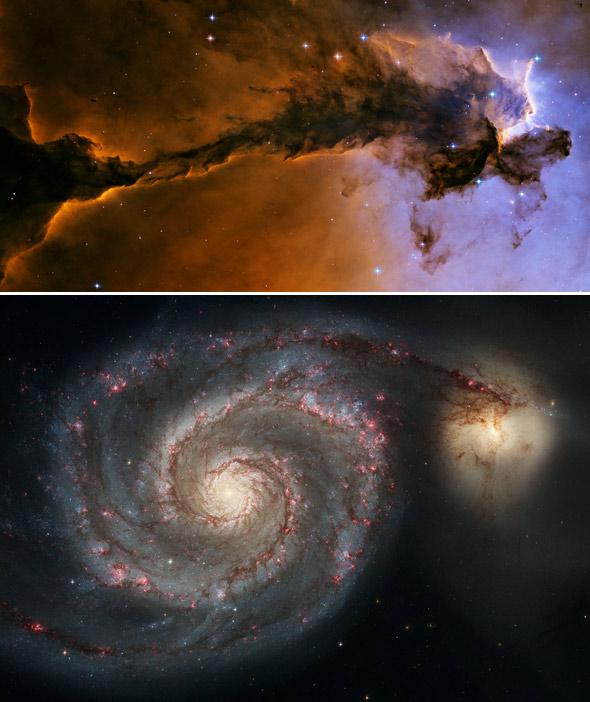Today, as I write this, it’s the 15th anniversary of the launch of the Hubble Space Telescope aboard the Space Shuttle Discovery (it was actually deployed from the Shuttle a day later; you can see a fun video of it here). If you haven’t seen them already, Hubble released two new images to celebrate: one of the Eagle Nebula, and the other of Whirlpool Galaxy.

Photo by NASA, ESA, and The Hubble Heritage Team STScI/AURA) & NASA, ESA, S. Beckwith (STScI), and The Hubble Heritage Team STScI/AURA)
I was going to write a brief history of Hubble, but you know what? You can find that anywhere. So I’m gonna indulge myself (it’s my blog, after all) and talk a little about my own involvement.
In the spring of 1990, I was at the University of Virginia, and I had just finished my Masters degree. I was looking for a PhD project, and having no luck. Most faculty had no money, or no project (one had a fantastic project observing variable stars that was incredibly cool, but she had no funding at the time). I scoured all the relevant departments at UVa, but there was literally nothing I could find.
I had actually written and printed what amounted to a resignation letter from grad school, which I was prepared to hand to the department chair, Roger Chevalier. But when I told him my tale of woe, he said “Well, I do have this one thing coming up…” I asked him what it was, and he said it was observing supernovae (exploding stars) with Hubble. I was fascinated by supernovae, and Hubble was due to launch in a few months, and was the Great Hope of Astronomy at that time. So duh: I said YES.
I still have that resignation letter.
I started reading on the project: it was a massive program to observe supernovae, involving many hundreds of hours total of observing time and a dozen professional astronomers across the globe. I was very eager to get involved, get data, gets started!
I was in for a shock, when it was found that the telescope wouldn’t properly focus (shortly thereafter I got a little salt in the wound: the variable star project I turned down received wheelbarrows full of funding. Figures). But Hubble did return two images of a ring of gas surrounding the supernova SN1987A, and they were good enough for me to start working. In all honesty, I had very little idea of what I was doing; it was a (very severe) learning process. But over time I got a grasp of it, and as new images from Hubble came in, I eagerly incorporated them into my work. I won’t go into details here, but you can read about that here and here.
I defended my PhD in ‘94, and went on to eventually work on the Space Telescope Imaging Spectrograph, or STIS, a camera on Hubble. It took many grand and gorgeous images of astronomical objects, and I was privileged to work on many of them, processing and calibrating the images, and sometimes working on the scientific analysis (even publishing one project).
I left that project after nearly five years, to pursue a career in public outreach in California. I still miss the work sometimes, and got a jolt when STIS died on August 3, 2004.
But I still look back very fondly on all the fun, work, sweat, pain, torture and sheer joy of working on the world’s premier telescope. I have many other stories about Hubble, including some of the work I did, in the Bitesize Astronomy section of the main website. You may find some of them amusing (especially this one, a personal favorite).
On this, the 15th year of its pushing back the boundaries of our knowledge, let’s hope that it continues for years to come. The decision to de-orbit Hubble is not final, and Mike Griffin, the new head of NASA, has said he wants to look into a Shuttle mission to repair the ailing observatory (it has failing gyros, which stabilize its pointing, and two new cameras are sitting on the ground waiting to be installed).
I certainly hope it continues on, and provides not just the public with the thrill of its spectacular images, but also gives scientists, both young and old, a chance to expand our knowledge of the Universe. For me, that’s what this is all about.